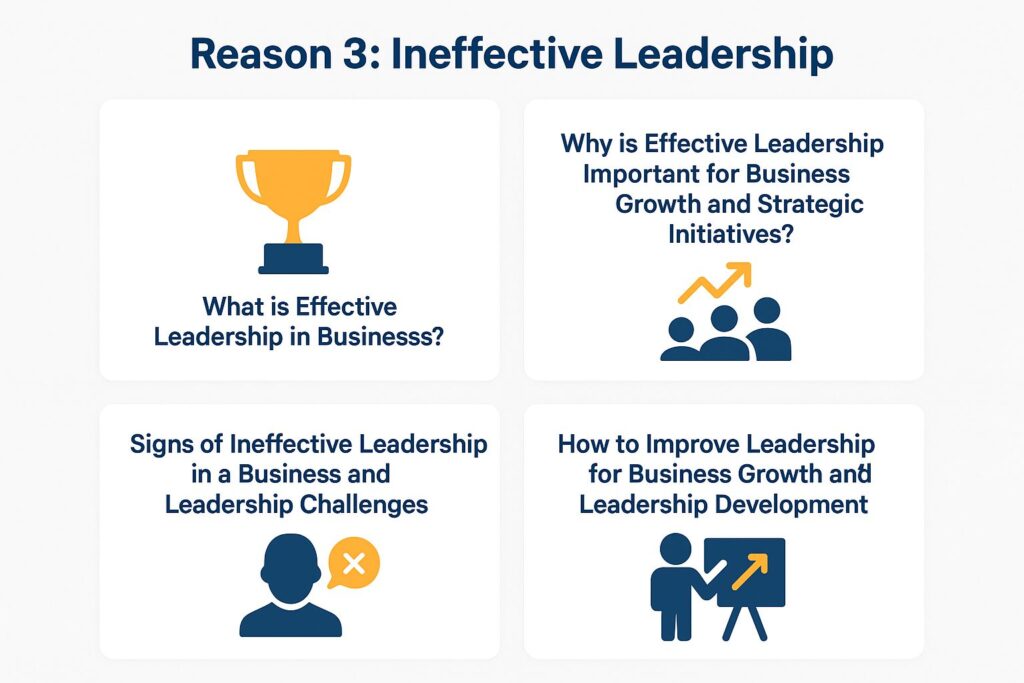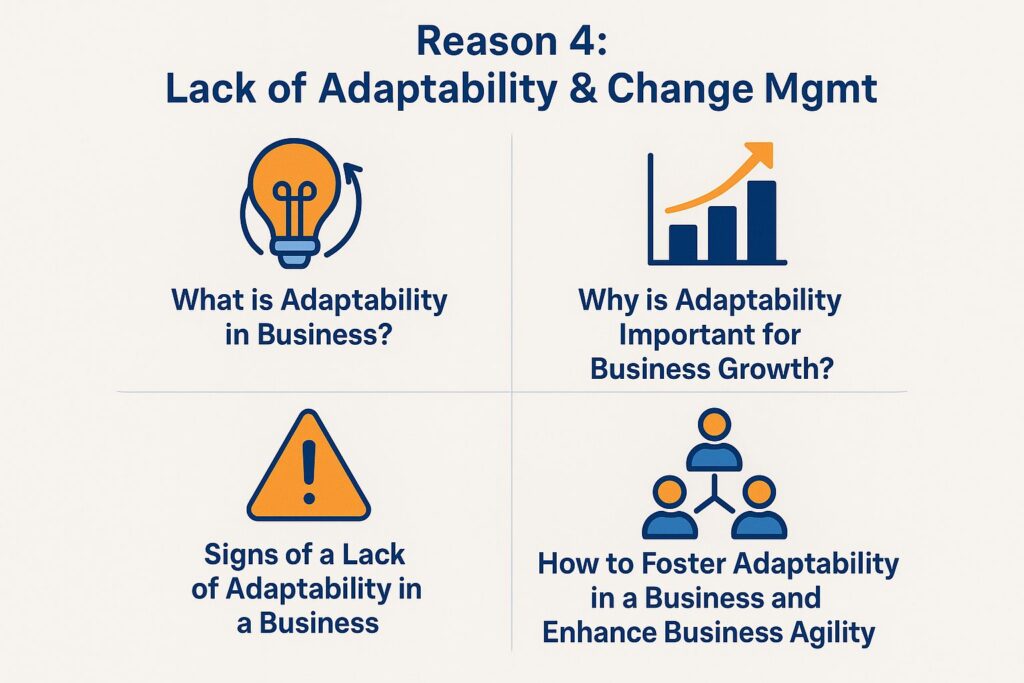
The Top Four Reasons Businesses Stopped Growing, And How Fix It
In the busy world of business today, stagnation can be a significant threat to growth and success. Many companies struggle to maintain their momentum due to various barriers, often leading to a decline in performance.
This article explains the main four reasons why businesses stop expanding: lack of innovation, poor marketing strategies, ineffective leadership, and lack of adaptability.
All reasons will be reviewed, as well as the warning signs and actionable solutions to help renew your business and spark its growth path. Learn how to get past these challenges and achieve long-term success!
Reason 1: Lack of Innovation and Market Research
If businesses aren’t innovative, they can face slow growth and fall behind as market trends shift and market competition grows.
Without encouraging new ideas, companies might struggle to handle economic changes and customer needs, which can hurt their brand recognition, customer engagement, and overall business strategy. It’s crucial for businesses to implement strategies that not only foster innovation but also ensure employee satisfaction. For instance, companies can explore compensation packages that attract and retain employees, aligning both employee needs and business goals.
Business Growth Challenges Statistics


Business Growth Challenges Statistics give a complete overview of the situation small businesses face, covering job effects, ownership details, financial condition, and reasons for business closure. Knowing these statistics can help business owners tackle challenges and achieve lasting growth by solving key growth issues and aligning strategies effectively.
Small Business Employment and Ownership highlights the significant impact small businesses have on employment, with 46.4% of the workforce employed by these ventures. This highlights their importance in the economy as main sources of employment. Meanwhile, 85.8% of employment by solopreneurs reflects the rise of independent business models. Ownership demographics show male-owned businesses at 56.6%, while female-owned businesses are at 43.4%, indicating gender disparities that need addressing for balanced representation. Minority-owned veteran-owned businesses, at 17.7% and 6.1% respectively, emphasize the continuous requirement for help and acceptance in starting new businesses. These numbers prove that having a mix of different people is important for creating successful companies and making them better at handling problems.
- Small Business Financials reveal that only 9% of businesses achieve revenues over $1 million, suggesting challenges in scaling operations. Yet, 65.3% of small businesses are profitable, indicating strong potential for those that manage resources effectively.
Small Business Failures point to critical areas of concern. 82% cite cash flow issues as a major failure cause, emphasizing the need for sound financial planning and management. While 42% fail due to lack of market need, this highlights the importance of thorough market research prior to launching. 20% failure rate in the first year and 50% survival rate over five years show the turbulent early stages of business growth, with only 34.4% lasting ten years, underscoring the long-term challenges.
The Business Growth Challenges Statistics highlight the importance of careful planning, handling money wisely, and knowing the market to help small businesses grow. These observations call for focused help and resources to improve long-term success in the business community, create a good customer experience, and support a culture of new ideas.
What is Innovation in Business?
Innovation in business means coming up with and using new ideas, products, or methods that make work better, make customers happier, and help the business grow.
This can include new products with unique features, improved processes that make operations more efficient and cut costs, or new business models that change how customers receive value.
As companies go through changes using technology, they find new chances to use tech and analyze data, helping them quickly meet consumer needs. For those interested in further expanding their business insights, exploring 10 must-follow blogs for small business growth can be quite beneficial.
By using different types of new ideas, businesses can stay competitive and gain a lasting benefit that helps them succeed in a constantly changing market.
Why is Innovation Important for Business Growth?
Innovation is important for business growth as it helps connect with customers, improves how operations are carried out, and gives an edge in the market by allowing businesses to expand successfully.
In today’s fast-paced economy, companies must prioritize innovative strategies to remain relevant and responsive to shifting consumer preferences.
As market conditions change, doing detailed competitor analysis becomes important, helping companies spot new trends and adjust their products or services accordingly. Their ability to change increases their capability to grow larger, allowing them to take advantage of new chances and maintain steady progress.
By using new and effective methods, businesses can understand and even predict what their customers want. This helps them stay strong in the market and keeps them competitive over time.
Signs of a Lack of Innovation in a Business
Signs of a lack of innovation in a business often manifest as sales decline, stagnant growth, and decreased employee productivity, indicating that the organization may be falling behind in its industry.
Further indicators can include low employee engagement scores, where team members feel disconnected from their work and unmotivated to contribute creatively.
Performance measurements might show a failure to respond to new market trends, shown by a lack of new ideas or unimpressive brainstorming sessions.
Organizations that do not create a supportive setting for new ideas often see employees reluctant to express their opinions or suggest fresh projects, resulting in a work culture that unintentionally limits creativity.
If new ideas are not focused on, negative effects spread throughout the company, affecting employee spirit and the potential to grow.
How to Fix a Lack of Innovation in a Business
To solve the problem of not having enough fresh ideas in a business, companies should make an environment that encourages creative thinking, effective use of resources, and thoughtful planning to handle changes in the market.
This requires encouraging employees to share their ideas and creating mentorship programs to link experienced workers with new talent.
When businesses focus on learning and trying new things, they can make use of the different viewpoints their teams have.
Thorough business analyses can identify gaps and opportunities, helping to make informed decisions. These methods create an active setting for fresh ideas, which is important for handling change effectively. This keeps the organization competitive in a market that frequently shifts.
Reason 2: Poor Marketing Strategies
Bad marketing strategies can hurt a business’s ability to gain and keep customers, resulting in fewer new customers, weak branding, and slowing down business growth. For small businesses looking to overcome these challenges, as mentioned in our discussion on 10 Must Follow Blogs For Small Business Growth, understanding effective marketing techniques is crucial.

What is Marketing in Business?
Marketing in business encompasses the activities and strategies that organizations use to promote their products and services, drive customer engagement, and establish a strong value proposition.
This field includes key areas like market research, which discovers customer preferences, and branding, which shapes the public’s view of a company.
Creating customer profiles helps customize marketing for different groups, making sure the messages connect with people while they are buying.
Knowing how customers interact with a business helps companies improve their plans. This leads to better relationships with customers and makes each step of their interaction easier.
By harmonizing these elements, businesses can create a cohesive marketing approach that maximizes outreach and drives sustainable growth.
Why is Marketing Important for Business Growth?
Marketing is important for business growth because it improves customer satisfaction, builds brand loyalty, and helps maintain a competitive advantage by clearly showing the value of products and services.
Good marketing plans directly connect to business goals, leading to outcomes that match company aims.
By carefully examining competitors, companies learn about their place in the market, helping them adjust their communication and products to satisfy the exact needs of their audience.
This plan brings in new customers and keeps current ones by showing that we know what they like and what problems they have.
In the end, if these plans are carried out effectively, they build a lasting connection between the brand and its customers, leading to ongoing loyalty and positive outcomes.
Signs of Poor Marketing Strategies in a Business
Signs of poor marketing strategies often include noticeable sales decline, negative customer feedback, and low engagement metrics, indicating that the current approach is not resonating with the target audience.
A failure to identify and connect with specific customer personas can lead to misguided campaigns that do not meet the needs or interests of potential buyers.
Lackluster social media interactions, minimal website traffic, and low conversion rates are further proof that strategies need reevaluation.
If the content produced does not inspire conversations or shares, it’s clear that the communication is falling flat.
If the brand doesn’t change according to performance data, it may lose its audience and become less important in a challenging market.
How to Improve Marketing Strategies for Business Growth
Improving marketing strategies for business growth involves using digital changes, strengthening online presence, and using social media to connect with the target audience effectively.
To succeed in today’s competitive market, companies should use data analytics and customer feedback in their strategy.
By analyzing customer behavior and preferences, businesses can tailor their inbound marketing efforts, ensuring that the right messages reach the right people at the right time.
Using customer feedback improves marketing plans, creating a personal experience that connects with potential customers.
Communicating directly with customers using surveys, polls, and chats builds better connections and aids in planning marketing strategies, resulting in growth over time.
Reason 3: Ineffective Leadership
Weak leadership can seriously hinder business growth.
Poor choices, unclear goals, and not involving employees can cause problems and lower productivity.

What is Effective Leadership in Business?
Good leadership in a company involves having a clear plan, communicating well, and encouraging employees to work towards shared objectives. These elements are important for achieving success in an organization.
Also, good leaders show flexibility and create a supportive work environment that promotes teamwork and creativity, thereby enhancing employee retention and reducing leadership challenges.
They realize that involving employees increases productivity and builds a team environment based on trust and responsibility, greatly affecting customer acquisition and improving resource distribution.
By actively listening to concerns and ideas, leaders can create an inclusive environment where each individual feels valued, driving commitment towards shared objectives.
They can find and grow talent, ensuring the company remains strong and gets ready for shifts in the business industry.
Why is Effective Leadership Important for Business Growth and Strategic Initiatives?
Strong leadership is important for business success because it encourages fresh ideas, increases employee productivity, and leads to outcomes like retaining customers and building the brand.
Leaders are important in creating a work environment where employees feel comfortable taking risks and sharing ideas. This openness is essential for handling risks well and ensuring smooth operations.
They contribute to creating a workplace where employees feel appreciated for their contributions, which results in innovative solutions, flexible practices, and improved operational efficiency.
By including regular performance reviews that look at both personal results and teamwork in developing new ideas, management can use business data to spot where improvements are needed and acknowledge successes, enhancing performance analysis and goal-setting capabilities.
This method helps teams stay involved and ready to react to shifts in the market, which in turn improves the organization’s ability to compete.
Signs of Ineffective Leadership in a Business and Leadership Challenges
Signs of ineffective leadership in a business often include high employee turnover, a lack of direction, and poor performance metrics, indicating that leadership is failing to guide the organization effectively and address leadership challenges.
These signs may also include difficulty in making fast and logical choices in critical situations, especially during emergencies, which can greatly affect operational problems and risk evaluation.
Leaders who have difficulty connecting with their teams might create a workplace where employees feel unappreciated and disconnected, which can worsen the organization’s issues.
Without clear ways to communicate, employees may be unsure about their jobs and duties, which can slow down how quickly the organization can respond to changes and effectively manage change resistance.
Ineffective leaders may overlook the importance of cultivating a proactive culture, leading to missed opportunities and increased vulnerability during challenging times.
How to Improve Leadership for Business Growth and Leadership Development
To improve leadership for business growth, organizations can implement mentorship programs, invest in leadership training, and promote continuous professional development among their team members, supporting workforce development and talent management.
They create an environment for learning, manage resources well, and make sure everyone feels important and confident, supporting wise use of resources and a focus on personal development.
This approach creates a setting where new leaders can grow with individual guidance and practical experiences.
Setting up regular feedback meetings and performance reviews can greatly increase employee productivity, enabling leaders to recognize strengths and areas that need improvement in their teams.
These strategies improve personal skills and help organizations succeed and stay strong in a competitive environment.
Reason 4: Difficulty in Adjusting and Managing Change
If businesses can’t change, they might struggle to grow. This makes it hard for them to deal with changes in the industry, market trends, and what customers want as the economy changes quickly.

What is Adaptability in Business?
Adjusting in business means changing plans, methods, and actions to handle shifts in the market and overcome difficulties, leading to strength and effective functioning.
This important quality helps organizations deal with surprise difficulties and issues, ensuring they can place resources where they are most needed.
When technology changes and customer needs alter, a business that can quickly change is more likely to benefit from growth opportunities, improve operations, and boost overall results.
By creating a workplace that values flexibility, companies can handle outside challenges and come up with new ideas that match their long-term objectives. This approach leads to ongoing success and a competitive edge.
Why is Being Flexible Important for Business Growth?
Being flexible is important for business growth because it helps companies take advantage of market opportunities, innovate successfully, and assess risks to deal with uncertainties.
In our fast-paced world, companies that encourage new ideas can quickly react to changing customer demands and market trends. By being flexible, these businesses can set performance measures that track progress and show where they can do better.
This proactive approach allows them to pivot strategies seamlessly, ensuring they remain competitive and relevant in a crowded marketplace. A strong commitment to being flexible encourages teamwork, promoting different ideas that lead to creative solutions.
The capacity to face new challenges increases operational strength and creates opportunities for long-term success.
Signs That a Business Struggles to Change
Signs that a business struggles to change often show up as slow growth, problems with operations, and employees losing interest, indicating the company is unwilling to change.
This resistance can be seen in falling engagement numbers, like drops in productivity and employee satisfaction, showing a workforce that is not keeping up with changing market needs.
Businesses may see higher employee turnover as workers look for places that support new ideas and flexibility. Not asking for feedback or using new technologies can show a lack of growth, causing poor decisions and slow responses to competition.
Studying these trends helps companies identify areas that need change to support stability and development.
How to Improve Flexibility in a Business and Increase Business Speed
To help a business become more flexible, companies can invest in employee training, encourage fresh ideas, and establish strategic partnerships that promote flexible and responsive plans, enabling innovation and competitive analysis.
When companies focus on getting employees involved, they build a workplace where people feel confident to offer their thoughts and start new projects. This improves everyone’s mood and introduces new methods to use resources more effectively.
Leaders should facilitate networking opportunities, allowing teams to collaborate across departments and learn from each other’s experiences. Adopting a mindset that views challenges as opportunities for growth can significantly strengthen an organization’s resilience.
Continuously learning and communicating clearly help employees deal with surprises and keep the company competitive and quick to react in a rapidly changing market.
About the Author
Ethan Cole is a business growth advisor and serial entrepreneur with over two decades of hands-on experience helping startups and small businesses thrive. With a background in finance and operations, he’s led multiple companies from early-stage concepts to multi-million-dollar exits. Ethan specializes in scaling strategies, cost reduction, and building systems that support sustainable growth. As a content contributor for Kwote Advisor, he shares practical insights to help business owners make smarter decisions when launching, managing, and expanding their ventures.



